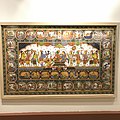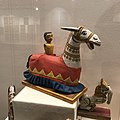
Puri district is a coastal district of the Odisha state of India. It has one sub-division, 11 tahasils and 11 blocks and comprises 1722 revenue villages. Puri is the only municipality of the district. Konark, Pipili, Satyabadi, Gop, Kakatpur and Nimapada are the NACs in this district while Brahmagiri being a semi-urban town.
DakshinaChitra is a living-history museum in the Indian state of Tamil Nadu, dedicated to South Indian heritage and culture. It is located 25 kilometres (16 mi) to the south of Chennai. Opened to the public on 14 December 1996, the museum was founded and is being managed by the Madras Craft Foundation (MCF). The MCF was established in 1984. Deborah Thiagarajan, an Indian art historian of American origin, governs the museum. The museum is built on 10 acres (4.0 ha) of land taken on a 33-year lease from the Government of Tamil Nadu. Located at Muttukadu, on the East Coast Road connecting Chennai and Pondicherry, the site overlooks Bay of Bengal.
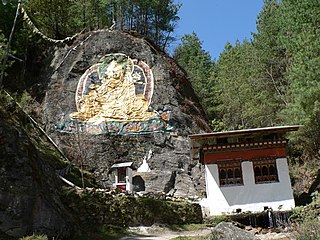
Bhutanese art is similar to Tibetan art. Both are based upon Vajrayana Buddhism and its pantheon of teachers and divine beings.
Iranian handicrafts are handicraft or handmade crafted works originating from Iran.
The Indian state of Odisha has a rich cultural and artistic heritage. Due to the reign of many different rulers in the past, arts and crafts in Odisha underwent many changes giving an artistic diversity today in the forms of traditional handicrafts, painting and carving, dance and music, clothing, etc.
Haku Vajubhai Shah was an Indian painter, Gandhian, cultural anthropologist and author on folk and tribal art and culture. His art belonged to the Baroda Group and his works are considered in the line of artists who brought themes of folk or tribal art to Indian art.

The National Handicrafts and Handlooms Museum (NHHM) commonly known as National Crafts Museum in New Delhi is one of the largest crafts museums in India. It is run by the Ministry of Textiles, Government of India. The museum is situated on the corner of the Pragati Maidan, facing the Purana Quila complex. In 2015, the Government of India announced that a Hastkala (handicrafts) Academy would be established in the museum premises, converting some galleries into classrooms. Initial renovations destroyed one of the museum's most well-known artifacts, a room of murals painted by Madhubani artist Ganga Devi, leading to widespread criticism. As of 2019, renovations are still ongoing.

Patachitra or Pattachitra is a general term for traditional, cloth-based scroll painting, based in the eastern Indian states of Odisha, West Bengal and parts of Bangladesh. Patachitra artform is known for its intricate details as well as mythological narratives and folktales inscribed in it. Pattachitra is one of the ancient artworks of Odisha, originally created for ritual use and as souvenirs for pilgrims to Puri, as well as other temples in Odisha. Patachitras are a component of an ancient Bengali narrative art, originally serving as a visual device during the performance of a song.

Raghunath Mohapatra was an Indian architect, sculptor, and a Nominated Member of Rajya Sabha. He was awarded Padma Shri in 1975 and Padma Bhushan in 2001. He was awarded Padma Vibhushan in 2013 on occasion of 64th Republic Day of India.

Artisans Angkor is a Cambodian social business creating job opportunities for young people in rural areas, while reviving traditional Khmer craftsmanship.

The Fort Sylvia is a historical fort in Kapit, Sarawak, Malaysia. Built in 1880, it was renamed after Rani Sylvia Brooke, wife of Rajah Charles Vyner Brooke, in 1925. During the 1960s, the fort housed the District Office and the District Court House, and later the Resident's Office when Kapit Division was formed in 1973.
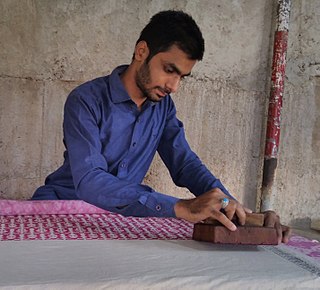
The crafts of India are diverse, rich in history, culture and religion. The craft of each state in India reflect the influence of different empires. Throughout centuries, crafts have been embedded as a culture and tradition within rural communities.

Kailash Chandra Meher is an Indian artist, inventor, and social activist. He is a painter of contemporary modern art paintings and traditional Tussar Pattachitra paintings of Odisha. He was a recipient of the Padma Shri by the Government of India in 2013.
Laila Tyabji is an Indian social worker, designer, writer, and craft activist. She is one of the founders of Dastkar, a Delhi-based non governmental organization, working for the revival of traditional crafts in India. She was honored by the Government of India in 2012 with the Indian civilian award of Padma Shri. She is the daughter of late Badruddin Tyabji, ICS, who was a senior Indian civil servant and diplomat.
The village of Pipili, Puri district, Odisha, India, is well known for its appliqué work, traditionally known as Chandua in India. "Appliqué" comes from the French word appliquer, meaning "to put on". There are two variants to this technique: appliqué, where a fabric shape is sewn over a base layer, and reverse appliqué, wherein two layers of fabric are laid down, and a shape is subsequently cut out from the upper layer, exposing the lower layer, before both are stitched together. It is one of the products which has been granted Geographical Indication (GI) by the government of India.
Kotpad Handloom is a vegetable-dyed fabric woven by the tribal weavers of the Mirgan community of Kotpad village in Koraput district, Odisha, India. Cotton sarees with solid border and Pata Anchal, duppatta with typical Buties / motifs, Scolrfs on cotton, silk, handloom stoles, and dress materials are all dyed with organic dyes. The natural dye is manufactured from the aul tree grown in this area. The Kotpad tussar silk saree with tribal art and Kotpad handloom fabrics with natural color is its specialty.
Gobardhan Panika is an Indian master weaver of Kotpad handloom a traditional tribal craft. The Government of India awarded him the fourth highest civilian honour of the Padma Shri, in 2018, for his contributions to the art of weaving.
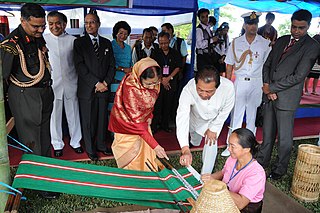
Mizo craft refers to as Mizoram handicrafts, is a traditional art and techniques of the inhabitants of Mizoram state, prominently known as the "Songbird of the North east". Its people are collectively known as Mizo. Mizo craftsmanship exists since ancient period. Its artisans use simple tools designed to produce traditional products. Handloom, cane and bamboo weaving are the core elements of its handicraft identity.

Handicrafts produced during the Qing dynasty (1644–1911) were objects designed and hand-made by craftsmen. They were heavily ornate, incorporating Tibetan, Middle Eastern, Indian, and European techniques. The design or decorative aspect of the craft was as important as the crafting technique itself and Qing artisans were particular about the materials they used, such as jade (yu), stones, and wood. In their designs artisans drew heavily from a number of motifs, both mythical and natural. Certain areas in China became well-known for specific types of handicrafts; for example, Jingdezhen was known as the capital of porcelain. During the Qing era, Imperial Workshops built in Beijing brought together artisans and raw materials that were once only obtainable in disparate regions. This allowed for the combining of technologies and materials to produce new types of handicrafts. The tributary system also brought new sources for materials and artisans that were not from the production centers.
The crafts of Sindh and its craftsmen are held in high esteem and their works are notable not only in Sindh but also in many other places.





